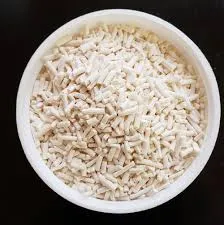
Choosing the Right Solvents for HPLC Applications and Improvements
Understanding HPLC Solvents A Key to Success in Chromatographic Analysis
High-Performance Liquid Chromatography (HPLC) is a vital analytical technique widely used in laboratories for separating, identifying, and quantifying compounds within a mixture. The effectiveness of HPLC is heavily reliant on the choice of solvents used in the process. These solvents play a crucial role in determining the resolution, sensitivity, and repeatability of chromatographic separations. Therefore, understanding HPLC solvents is essential for achieving optimal results in various analytical applications.
Types of HPLC Solvents
HPLC solvents can be broadly categorized into two types aqueous solvents and organic solvents. Aqueous solvents primarily consist of water and may include buffers to maintain a specific pH. Buffers are crucial in controlling the charge state of analytes, thus affecting their interaction with the stationary phase during chromatography. Common buffers include phosphate, acetate, and citrate.
On the other hand, organic solvents such as acetonitrile, methanol, and tetrahydrofuran are often used because of their ability to dissolve a wide range of chemical compounds and their low viscosity, which allows for better flow through the HPLC system. The choice of an organic solvent typically depends on the nature of the analytes being studied. For instance, nonpolar compounds may require nonpolar solvents, while polar analytes might necessitate polar solvents.
Importance of Solvent Quality
The quality of HPLC solvents is paramount in obtaining reproducible and reliable results. HPLC-grade solvents are manufactured to have low levels of impurities that could interfere with the detection of analytes. Impurities can lead to baseline noise, peak tailing, and, ultimately, erroneous results. Therefore, it is advisable to use highly purified and properly stored solvents, preferably those sourced from reputable suppliers.
hplc solvents

Additionally, the solvent's compatibility with the HPLC system and the detection method employed should also be taken into consideration. Some solvents can degrade certain HPLC column materials, leading to column damage and affecting the overall performance of the chromatographic system.
Optimizing Solvent Composition
To enhance separation efficiency, it is often necessary to optimize the composition of solvents. This can involve adjusting the ratio of aqueous to organic solvents to create a mobile phase that is best suited for the specific separation task. Gradient elution, which involves altering the solvent composition over time, is a common technique used to improve the separation of complex mixtures. By starting with a less polar solvent and gradually increasing the polarity, scientists can better resolve closely eluting peaks.
Environmental Considerations
With the growing emphasis on sustainability, the use of solvents in HPLC is also under scrutiny. Many laboratories are shifting towards greener solvents that are less toxic and more environmentally friendly without sacrificing performance. Alternatives such as ethanol and propylene carbonate are being explored as potential components in mobile phase compositions. This shift not only helps reduce the environmental impact but can also minimize health risks associated with hazardous solvents.
Conclusion
In summary, the choice and quality of solvents are fundamental to the success of HPLC analyses. A better understanding of the types of solvents, their properties, and the importance of solvent optimization can greatly influence the quality of results obtained from chromatographic methods. As the field of analytical chemistry continues to evolve, staying informed about advancements in solvent technology and environmental considerations will be essential for researchers aiming to enhance their analytical capabilities.
-
Pure Sodium Dichloroisocyanurate Dihydrate | Powerful DisinfectantNewsAug.29,2025
-
Industrial Chemicals: Quality & Purity for Every IndustryNewsAug.28,2025
-
Nitrile Rubber Honoring Strict Production StandardsNewsAug.22,2025
-
Aspartame Ingredients Honoring Food Safety ValuesNewsAug.22,2025
-
Fertilizer for Balanced Plant NutritionNewsAug.22,2025
-
Cyanide Gold Processing with High Purity AdditivesNewsAug.22,2025
-
Formic Acid in Textile Dyeing ApplicationsNewsAug.22,2025
Hebei Tenger Chemical Technology Co., Ltd. focuses on the chemical industry and is committed to the export service of chemical raw materials.
-

view more DiethanolisopropanolamineIn the ever-growing field of chemical solutions, diethanolisopropanolamine (DEIPA) stands out as a versatile and important compound. Due to its unique chemical structure and properties, DEIPA is of interest to various industries including construction, personal care, and agriculture. -

view more TriisopropanolamineTriisopropanolamine (TIPA) alkanol amine substance, is a kind of alcohol amine compound with amino and alcohol hydroxyl, and because of its molecules contains both amino and hydroxyl. -

view more Tetramethyl Thiuram DisulfideTetramethyl thiuram disulfide, also known as TMTD, is a white to light-yellow powder with a distinct sulfur-like odor. It is soluble in organic solvents such as benzene, acetone, and ethyl acetate, making it highly versatile for use in different formulations. TMTD is known for its excellent vulcanization acceleration properties, which makes it a key ingredient in the production of rubber products. Additionally, it acts as an effective fungicide and bactericide, making it valuable in agricultural applications. Its high purity and stability ensure consistent performance, making it a preferred choice for manufacturers across various industries.





